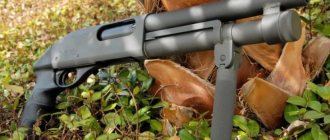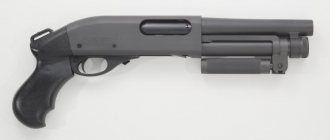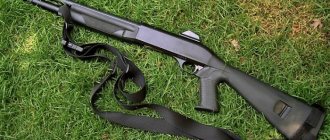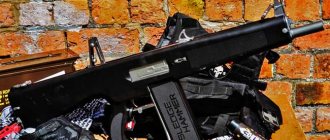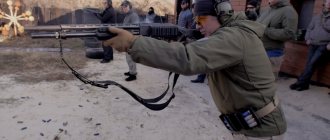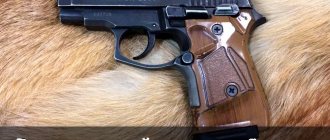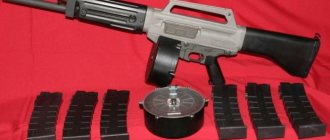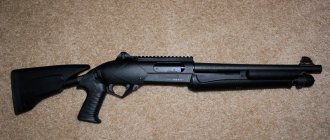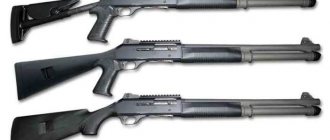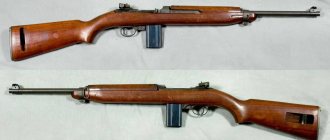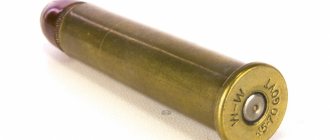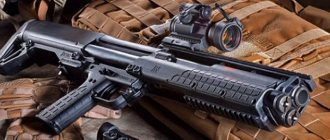The High Standard HS-10 is a compact 12-gauge semiautomatic shotgun produced by the American arms company High Standard Manufacturing Company in the 1960s and 1970s. The smoothbore combat shotgun was originally intended for the military, special forces, law enforcement, and police, as it was even invented by a police officer. Subsequently, the police abandoned the High Standard HS-10 due to the shotgun’s not the best reliability indicator and questions about the operation of its mechanics, after which the self-loading gun entered the civilian market and was removed from mass production.
In this article we will tell you in detail about this compact combat shotgun, consider its tactical and technical characteristics, design, and analyze the shortcomings that prevented the HS-10 model from becoming popular and in demand.
History of creation
For several years, from 1957 to 1961, American police sergeant Alfred Crouch refined his design of a smooth-bore firearm designed in a bullpap configuration, and having completed the first prototype in 1961, he finally patented it, after which he presented his shotgun for consideration by various commissions from weapons in its homeland, in the USA.
At that time, the “bullpap” scheme was exotic, and a significant part of high-ranking officials around the world and at all times, as is known, are wary of everything fundamentally new and are distinguished by conservatism based on fears of “getting hit” by their superiors, preferring everything is old and proven.
For this reason, it is quite difficult to make way for fundamentally new and little-tested designs, including in the niche of individual firearms.
The developer of this smooth-bore semi-automatic machine, Alfred Crouch, declared his device as a combat shotgun capable of firing with one hand, and for several years repeatedly contacted various US weapons companies, but without success, his “device for firing with one hand” (quote from the patent for the invention Crouch) did not arouse much interest.
At that time, the popular Remingtons, Winchesters, and Mossbergs were already selling well and were quite in demand among various army units, law enforcement agencies and security agencies, as well as among civilian customers around the globe. The bullpup design was not popular in the 60s; today we see a different picture, but Crouch’s shotgun was somewhat ahead of its time.
Ultimately, Alfred was lucky: in 1965 he managed to break through the blank wall of refusals and find a buyer for his original development. The American company High Standard Manufacturing Co, specializing in the production of pistols and shotguns, became the “lucky owner” of all rights to Crouch’s invention and to the production of this shotgun.
To be more precise, Alfred does not reinvent the wheel, but reworks the very successful smooth-bore semi-automatic Remington 11-48 (which by chance ended up in Crouch’s possession) and supplements it with a set of parts that allows it to be turned into a self-loading shotgun with a bullpup layout configuration, executed according to the classic scheme.
But Crouch's main feature was the ability to fire controlled fire from a 12-gauge shotgun, shooting with one hand.
The conversion of the Remington 11-48 shotgun consisted of a set of parts: a pistol grip with a plastic fore-end and an aluminum bullpup stock. The butt had a curved butt plate (bracket) rotating around its axis, replacing the traditional wooden butt. Thanks to this modification, the buttplate can be moved from a vertical to a horizontal position, making it possible to fire a shotgun with one hand, resting the curved buttplate against the biceps of the hand firing from the shotgun, having previously turned the buttplate horizontally.
The Collapse of an American Legend
By American standards, a gun should be universal in order to protect the house and go hunting.
But the glorious military past of hard drives somehow overshadowed their use in hunting. Before the revolution, good American multi-chargers came to our country legally, during the Soviet era - through smuggling, through Chukotka (and to this day they surface in the Far Eastern region of Russia). Today, alas, this legendary brand has sunk into oblivion. Of course, global arms concerns, having bought up old brands, continue to produce weapons under this name. But these are no longer the high-quality legendary weapons products of the American arms industry, but modern faceless European or Japanese crafts. Is such a weapon good or, to put it mildly, “so-so”? This is a very difficult question, and perhaps there is no clear answer to it.
We must always remember that traditional American weapons were produced under the Winchester brand. Among European hunters, which includes us, the use of such systems specifically as hunting ones causes a certain sarcasm. Let's take, as an example, the famous Winchester M12 pump-action model, designed by Thomas Crosley Johnson based on the Winchester M1897 model, the author of which was John Browning himself. As the name implies, this gun was born in 1912, was produced until 1963, and about two million copies were produced in total. Today this is one of the most popular models in the United States, the price of which has only increased over the years.
The characteristics of a gun indicate solely its hunting purpose. The release of the new M12 shotgun was launched by Winchester initially in 20 gauge, which was called the Perfect Repeater. In 1914, 12- and 16-gauge models were created, and in 1934, 28-gauge models.
But everything else points to his “security functions”, which are completely alien to the hunter. There is no magazine cut-off, the trigger does not have a disconnector, as a result of which the gun can be fired in two ways. In the first case, shooting is carried out as usual, as with most pump-action shotguns. In the second, when the trigger is constantly pressed, the fore-end twitches, after it is sent to the extreme forward position and the barrel is locked with the bolt, the shot follows automatically. Similar trigger schemes are used, as a rule, in pump-action shotguns intended for combat operations.
| The legendary Winchester M12 is the weapon symbol of America. It was produced for more than half a century in various modifications. Today it is the most sought-after pump-action shotgun on the aftermarket in the United States. |
| Modern pump-action SXPs do not have the same charisma as genuine American Winchester weapons, despite the preserved trademark. |
When reloading a weapon after firing, the fore-end must be moved slightly forward, and after that - back, for reloading.
The forend interacts with the bolt frame through a single rod, but this does not prevent the gun from functioning reliably. Loading and unloading confidently requires certain skills. For transportation, the gun is disassembled into 2 parts - the stock with the receiver and the barrel with the forend. It is clear that “proper European” hunters do not accept such weapons, and their main sales were in the USA. By American standards, a gun should be universal in order to protect the house and go hunting. In this regard, the M12 is a classic, a collective image of what Americans consider their weapon symbol. The quality of execution of such guns is amazing: no cheap surrogate materials and technologies, only steel, wood, milling. Performance characteristics are also excellent: excellent balance, excellent sitting position. By modern standards, the production costs for such guns would simply go through the roof, but back in the 1960s, such quality was the norm and such weapons were affordable even to poor buyers.
During the First World War, having a huge military order, the Winchester Reaping Arms Company managed to get into debt; its loans were aimed at expanding production. After the war, the company began producing by-products - knives, rollers for refrigerators - anything that could make a profit. But hopes of quickly getting out of the debt hole did not materialize. And in 1931, the famous arms company, a symbol of America, was sold to the industrial group Olin Western Cartridge Company. Oddly enough, such a turn did not harm the arms company. Moreover, John M. Olin, the first vice president of the industrial group that included the Winchester plants, restored the faded brand to its former glory, and the 1930s and 1940s are considered a rebirth of the old brand.
At the beginning of World War II, the Winchester Repairing Arms Company developed and manufactured 818,000 units of the M1-Garand rifle, no less legendary than the Winchester. Until the end of the war, these weapons were produced under license by many companies, and after the war the M-1 was replaced by a new rifle - the M-16, from a different company.
After the end of the war, America's arms industry began to stagnate. But while other companies were getting by by selling “short-barreled guns”—pistols, revolvers and ammunition for them—then the huge plant in New Haven, which had never produced such products, was becoming more and more “bent.”
And competitors were not asleep at this time. The turning point for the former Winchester Repiting Arms Company was 1963–1964, when the company's management made a number of strategic mistakes. A design team was formed at Olin facilities to integrate “modern” engineering design methods into production and improve product manufacturability. It was the work of this group that “killed” the Winchester brand. Excellent but difficult to manufacture systems have been replaced by cheaper ones. The new model range, which replaced the Winchester classics, caused an extremely negative reaction not only in arms circles, but also among buyers. It is clear that manual labor was rapidly becoming more expensive, but it was largely due to the cult models that the prestige of the weapons brand was maintained, and therefore, this is what determined the demand for it.
Even the most popular M12 was discontinued. It was replaced by the cheaper and more technologically advanced Winchester 1200/1300 model. To be frank, it was not only a matter of profit: the eternal struggle for buyers with Remington also had an impact. And Winchester lost it. What do we see? Offhand, we can name such legendary models from Winchester as M1866, M1873, M1887, M1894, M1895, M1897, M1903, M1905, M1907, M1910, M1911, M12, M52, M54, M70! But they were all developed before World War II. And in fact, until 1964, the company lived on old designs, which were very, very popular, despite the fact that some of them were designed back in the 19th century. Since 1964, only two models have appeared that have become popular: the Winchester 1200 and its further development, the Winchester 1300. Attempts to revive were ongoing. The company tried to enter the market of related products by producing stoves, lanterns, tents, sleeping bags, etc. Worker costs continued to rise throughout the 1960s and 1970s. After a long strike in 1979–1980. At the Olin weapons factories, a decision was made to abandon the production of firearms altogether.
| An author's engraving on a modern hunting hard drive is, of course, beautiful, but such a gun is still for the interior, and not for hunting. |
In December 1980, Winchester's New Haven plant was sold to its employees and became part of the US Repeating Arms Company. At the same time, Olin retained the “Winchester business” of ammunition. In 1989, the US Repeating Arms Company went bankrupt. And ultimately, the famous American factories were sold to the Belgian Herstal Group, which owns such famous arms companies as Fabrique Nationale d'Herstal (FN) and Browning Arms Company.
On January 16, 2006, US Repeating Arms Company announced the closure of the New Haven plant where the famous Winchesters were manufactured for 140 years. This moment can be considered the last gasp of the famous American arms brand. After that, only surrogates remained! On August 15, 2006, Olin Corporation, still owning the Winchester trademarks, entered into an agreement with Browning Arms Company and production of the surrogates began. M1885, M1892, M1886 were produced under license by the Japanese corporation Miroku and... imported to the United States by Browning Arms Company. In the summer of 2010, Fabrique Nationale d'Herstal resumed production of the Winchester 1894 model and the Winchester 1300 modification, today called SXP (Super X Pump).
Today, many low-quality products are sold under the Winchester brand - Chinese folding knives, various tools, etc. New, supposedly “Winchester products” are, as a rule, already known weapons with a number of simplifications and changes. For example, today's Winchester Super X3 is just a clone of Browning Gold. This is no longer a “Winchester weapon”, but an exploitation of a famous brand. The quality of such weapons is not the famous American one and not the mediocre Turkish one. By modern standards, this is a quite good and reliable weapon, but somehow utilitarian and faceless. There is not even a trace of the once legendary status. Just inexpensive clones - that's all! That, however, does not prevent them from being good hunting rifles.
Sergey Klishin May 16, 2013 at 00:00
Revision of High Standard HS-10
High Standard engineers refined Crouch's concept, replacing the solid aluminum stock with a plastic one assembled from three main parts, and also added such useful details from the point of view of military weapons as an integral carrying handle and a combat light located above the barrel in the front of the handle.
The basis of the new weapon was the gas-operated self-loading shotgun of the High Standard company, model Flite King 12 gauge. The combat shotgun, designated the High Standard model 10A (HS-10A), went into production in 1967 and was sold only to police departments and other government agencies.
In 1970, the design of the Model 10 was slightly improved - the integral carrying handle was replaced with a side folding one, the front sight from the handle was moved to the barrel and became foldable, and a second handle for loading the weapon appeared on the left side of the weapon. This model was designated High Standard model 10B (HS-10B). It was already sold not only to the police, but also to private individuals.
At first, Model 10 shotguns became quite popular among police officers, but after a few years, police departments began to get rid of these guns - the Model 10 turned out to be too unreliable, especially when using medium or low power cartridges. The magazine capacity of only 4 rounds also seemed insufficient for a military weapon. As a result, the Model 10 was discontinued and most of these guns ended up in the hands of civilians who bought them cheap at police salvage sales.
Trench shotgun: a melee weapon in the US Army
Header photo: American soldier in Iraq armed with a Mossberg 500 trench shotgun.
What is the best weapon? That which corresponds to the conditions of warfare. In some places, a pistol is enough as a melee weapon, but in others, only tactical nuclear weapons can even the score. And the army must respond quickly to changes in these very conditions. And sometimes quite interesting results are obtained, as, for example, in the story about the “trench shotgun”.
It may seem strange to you that at the end of the 19th century, shotguns were practically not remembered in the US Army. And this despite the sincere love of the descendants of cowboys for the “coachman’s guns.” But first things first.
The content of the article
Trench Shotgun: Early History
For a long time, the US Army made do with standard long-barreled rifles, which were also used as melee weapons. Well, linear tactics have changed little since the War of Independence, except that the rate of fire has increased somewhat.
The soldiers still had to fire at the dense ranks of the enemy’s colorful uniforms, occasionally fight off crushing cavalry attacks (and cavalrymen, by the way, even wore armor in those days), and pray that the enemy’s artillery would not pay attention to them. And it went on like this for a long time. Until the Philippine campaign, during which the US Army realized that “what the fuck is going on here, how to fight?”
Philippines
So. 1898 As a result of the Spanish-American War, the Philippines ceded to the United States. It’s just that the residents of the Philippines themselves didn’t agree with someone else’s treaties, so they declared independence and started a war of national liberation.
And then the Americans realized that they were in deep trouble. Of course, in an open clash, the expeditionary force easily defeated 15 thousand soldiers of Emilio Aguinaldo, suffering virtually no losses. Even the final defeat and capture of this same Aguinaldo in 1901 did not solve anything, because the Americans were stuck in something they had not yet learned to cope with - guerrilla warfare.
Among other trophies captured from the Filipino rebels, called "Moros", were pump-action shotguns.
Long rifles are almost useless in the jungle. Bullets are easily deflected; water, dirt and other nasty things damage the mechanism. And the Colt M1892 revolver turned out to be poorly effective. And I had to remember the old proven method of firing at a short distance - the M1897 pump-action shotgun , a wonderful close-combat weapon, authored by Mr. Browning .
According to some reports, already in 1900 about 200 of these “Winchesters” were purchased. And by 1901, an official request for an additional thousand M1897 had already been submitted. The weapon was so effective that many officers purchased it for themselves with their own money. At least, a certain Captain John Pershing initially did just that, assessing the characteristics of the shotgun.
World War I. Trench shotgun with M1917 rifle bayonet.
But despite new supplies of shotguns, the United States formally lost the war. The Philippines received autonomy status, and the Americans received one of the greatest military humiliations.
World War I
John Pershing survived. He rose to the rank of general and became the commander of American armed forces in Europe during the First World War. And it was there that he remembered that trench warfare was the same as chasing Moros through the jungle. At least from the point of view of effective firing range and the need to immediately suppress any signs of enemy life.
As a result, American soldiers began to be equipped with a melee weapon called the “Trench Gun,” which means “trench shotgun.” Essentially the same “Winchester” from 1897, only with a light casing on the barrel and a bayonet from the M1917 . However, then the design changed somewhat and the new M1912 shotgun with a closed trigger firmly gained its popularity in the ranks of the US armed forces.
One interesting “joke”: There are still comrades who claim that the “trench shotgun” is prohibited by the Geneva Convention. They say that a shotgun is very destructive and traumatic - such a dangerous melee weapon could not but be banned. Unfortunately no. Yes, it is quite possible to tear off limbs with shot, cause large-scale damage, and completely clean out any bunker with one successful volley. But unlike bullets with a displaced center of gravity and explosive bullets, the soldiers suffered much less. Here he either died immediately or climbed out, possibly at the cost of losing a limb. And the very idea that shotguns should be banned was launched by very humane Germans. Who really didn’t like the overwhelming advantage of shotguns during trench warfare. At the same time, they preferred to remain silent about their flamethrowers, used for exactly the same thing, only in much more barbaric ways. Well, okay, hypocrisy in war is absolutely normal.
After the end of the First World War, no one was in a hurry to put their favorite melee weapons into storage. As they knew, at first the “trench shotgun” came in handy during the “banana wars” in African countries, as did the experience in the jungles of the Philippines.
World War II, US soldier with a shotgun.
And then World War II broke out. Although the shotgun was somewhat replaced by submachine guns, which were also quite effective in clearing out fortified points.
Vietnam
And again “Johnny” had to grab the M1897, M1912, as well as the M37 “Ithaca” - the latest development of the same Browning, and the M870 “Remington” . The latter, however, did not live up to expectations. At first they wanted to entrust it to the Navy SEALs, but the impressive firepower did not compensate for the relatively low rate of fire, high recoil and insufficient reliability.
The Navy SEALs' weapons during the Vietnam War included semi-automatic shotguns.
So the SEALs had to look for another weapon. It was the M500 Mossberg . Simple as a log, reliable as a Kalashnikov assault rifle, inexpensive and effective. And with the light hand of the US Marines, he received well-deserved glory. Now he is in the special forces, and in the police, and not only in the USA.
Iraq
Sandstorms, ubiquitous sand, clearing of populated areas and limited visibility - you can’t imagine better conditions for the M500. And how wonderful the Mossberg door bouncer locks are – the fighters couldn’t be happier. Even the brand new M1014 ( Benelli M4 ) were abandoned, since fine dust negated the entire advantage of semi-automatics.
In the army, a shotgun is called the “key to all doors,” and a soldier armed with a shotgun is called a “breacher.” Photo: A soldier prepares to open a door with a shotgun.
Melee weapons in the US Army: present and... future?
Shotguns are now in service with every active combat unit of the US Army as a close combat weapon. The only question is how quickly the reliable and simple M500 will be supplanted by its advanced and high-tech competitors.
Mossberg 500 Tactical - Tri-rail Forend. Modern tactical shotgun. Although in essence it is the same trench melee weapon.
Considering that the M1897 lasted more than half a century, the Mossberg, and taking into account the ease of modification, has more than good chances. But this is exactly what an ideal weapon should look like - powerful, simple, convenient and versatile. It's like a shotgun.
Original article – A tool for short-term warfare
Design features and operating principle
The base of the High Standard model 10 series shotguns is the Flite King self-loading shotgun of the same company, which has an under-barrel tubular magazine for 4 rounds and a gas release mechanism with an annular piston located around the magazine tube. The barrel is locked by tilting the bolt, ejecting the cartridges to the right side, loading through the window in the lower part of the receiver. The return spring is located under the barrel, around the magazine, which made it possible to convert the basic shotgun into a bullpup configuration without much difficulty.
The body of the Model 10 is made of plastic, and consists of three main parts - back, top and bottom. The parts are connected to each other by a horseshoe-shaped metal retaining piece in the center, and are attached to the weapon with a screw magazine cover at the front and a screw that secures the butt plate to the receiver at the rear.
The trigger is connected to the firing mechanism by double wire rods. The safety is located in front of the trigger guard and looks like a transverse button. When turned on, the safety lock blocks the trigger rods.
American guns
American guns
Emigrated to America at the beginning of the 18th century. German and Swedish hunters took guns with them, which made it possible to set up workshops in a new place and begin to use guns in the New World. It didn't take long before the need for guns that suited local conditions arose. Then the octagonal trunk was lengthened, and its size began to be from 3 to 4 feet, sometimes they turned out to be even longer. In this way, it was possible to increase the burning time of the gunpowder, which, in turn, led to an increase in hit accuracy.
In an effort to reduce the weight of the product to a minimum, the caliber was reduced, and it began to vary from 0.45 to 0.60 inches, and by the end of the century its value ranged from 0.40 to 0.45 inches. The reduction in caliber forced the hunter to take with him a large supply of bullets made of lead. From 1 pound of lead it was possible to make 48 bullets with a diameter of 0.45 inches, identical in action to 16 bullets of 0.70 inch caliber. That’s why the flask for gunpowder was used for so long: it was used by those hunters who found themselves far from civilization.
The straight stock gave way to a sleeker design with a downward curve and a convex section for the cheek rest. The elegant trigger guard and copper trim on the stock have also been preserved. It was an elegant and deadly weapon (photo 100).
American long rifles, manufactured mainly in Lancaster and Bucks County (Pennsylvania) and in the neighboring states of Virginia and New York, turned out to be more accurate than European models. During the Civil War, there were many stories of people killed by shots fired at 400 yards because shooting conditions were nearly perfect.
To verify the veracity of these stories, in 1924, a certain John Dillon conducted a test using three guns made in Kentucky. The first of them was with spiral channels, the second with straight channels, and the third was smooth-bore. Each gun was fired at distances of 100, 200 and 300 yards at a human target. The results clearly confirmed the superiority of the conventional shotgun and allowed us to conclude its accuracy when shooting at long distances.
Let us provide comparative data.
| Distance | Guns | Number of hits |
| 100 yards | with spiral grooves | 10 |
| straight cuts | 10 | |
| smooth drilled | 10 | |
| 200 yards | with spiral grooves | 10 |
| straight cuts | 5 | |
| smooth drilled | 4 | |
| 300 yards | with spiral grooves | 5 |
| straight cuts | 2 | |
| smooth drilled | 1 |
Further testing showed that small caliber bullets could penetrate 2.5 inches into a chestnut tree at a distance of 50 feet and 3
/
4
inches into a chestnut tree at a distance of 300 yards, causing mortal terror and striking small to medium-sized game at longer distances.
Before the Civil War, America had a wide variety of game. During the hunt, in the southern states they tried to use certain hunting methods used in Europe. Around 1760, a piece of land was cleared in the vicinity of Pomfret Castle and thus formed the center of a circle several miles in diameter. Barking, growling and mooing animals were gradually driven into it.
A group of buffaloes rushing through the circle of guards allowed several hundred animals to escape, but still, when the shooting was finished, the number of animals included in the list that remained killed turned out to be significant. The results were recorded as follows: 41 panthers, 109 wolves, 112 foxes, 114 mountain cats, 17 black bears, 1 polar bear, 2 moose, 198 deer, 111 bulls, 1 otter, 12 wolverines, 3 beavers and almost 500 small game.
Of course, this didn't happen often. Turkey shooting turned out to be a traditional hunt in communities scattered across the country: the bird was buried in the ground or hidden behind a log, so that only the head stuck out, and it became the target.
Specifications
The performance characteristics of the High Standard HS-10 smoothbore shotgun are presented in the table below.
| Manufacturer country | USA |
| Caliber (mm) | 12 gauge (18.4 mm) |
| Year of issue | 1967 |
| Fire Modes | Single |
| Cartridge | 12/70 |
| Shop | 4 rounds in a tubular under-barrel magazine |
| Barrel length (mm) | 457 |
| Gun length (mm) | 686 |
| Weight, kg) | 3.63 without flashlight |
| Type | Smoothbore semi-automatic |
| Status | Out of production |
Modifications of HS-10
Not many modifications of the High Standard HS-10 have been developed, but there are a couple.
- Shotgun High Standard HS-10A. On the 10A model, the carrying handle is integral, it has sights built into it and a tactical flashlight in the front.
- Shotgun High Standard HS-10B. On the 10B model, the handle is foldable, the rear sight is made on its fixed base, and the rear-folding front sight is mounted on the barrel. The flashlight is removable and is located in front of the handle.
In all variants, the HS-10 shotgun was made only in 12 gauge, the barrel chamber was 70 mm long (12/70), that is, it was not designed to fire 12/76 Magnum cartridges. Sights with an extremely short sighting line were located on the upper plane of the transfer handle.
Advantages and disadvantages
In general, the strengths of the High Standard HS-10 self-loading shotgun are more or less clear, but what about the disadvantages, this is worth talking about separately.
In the first years of the release of the High Standard model 10 series, combat shotguns were widely popular and famous, especially among law enforcement agencies and bank security, but practical experience of use showed a number of significant shortcomings of this semi-automatic weapon.
A shotgun with a bullpup configuration turned out to be not the most reliable weapon when compared with the old proven pump-action system that the Americans loved so much. The mechanics of the HS-10A, like the HS-10B, turned out to be unreliable; it periodically jammed when using medium or low-power cartridges, and the small magazine capacity for only four cartridges turned out to be clearly insufficient for even a short battle.
This was the death sentence for the High Standard model 10 series of shotguns, and by the end of the 70s their production ceased completely. Law enforcement agencies, in particular the US police department, are beginning to urgently get rid of a large batch of purchased HS-10B series shotguns, selling them to private individuals at sales and auctions of decommissioned police property.
Another problem was that the Model 10 could only be fired with the right hand, as the pistol ejected spent cartridges from the right side of the block with great force. There's even a warning on the right side of the gun: "WARNING - DO NOT SHOOT WITH YOUR LEFT SHOULDER."
It is possible that now, when bullpup systems are no longer in doubt, this semi-automatic, with appropriate modifications, could find a second life. After all, Crouch’s idea of unifying long-barreled weapons for shooting both aimed, with emphasis on the shoulder, and from the belt, with emphasis on the biceps, is very original and looks attractive.
Currently, most of the High Standard model 10 series autoloading shotguns are in private ownership among firearms enthusiasts and collectors.
The interesting appearance of the High Standard HS-10 shotgun did not go unnoticed by computer game developers. For example, the HS-10 shotgun can be found in the cult shooter Call of Duty.
Winchester Model 21. Why is this gun called the “American classic double-barreled shotgun”?
Here is America and the pump-action shotgun, yes, that’s how it should be... And the double-barreled shotgun... The author clearly doesn’t understand something.
And yet... In the ranking of the most expensive guns in the world (conducted annually by the popular news channel CNN), this gun, which was once produced as a “gun for the poor,” has not been out of the top ten most expensive guns in the world for many years and is considered the most expensive gun America. True, in the catalogs the gun is called “Connecticut Shotgun Manuf.” Co. Model 21". However, it is produced under a 1920 patent and proudly bears the logo of the long-deceased Winchester company.
Production of the Model 21 began in America in 1930. However, Winchester names its models as the year in which the production of weapons began. Contradiction?
Not at all! It’s just that the first Winchester double-barreled shotguns were made in England and sold as just a Winchester shotgun, without a model designation, and when the production process was thoroughly studied and almost completely mechanized, production was moved to America. Double-barreled shotguns were produced as “guns for workers,” that is, for the poorest who could not afford a rifle, a pistol, or even a cheap pump-action gun.
The design, compared to European double-barreled shotguns of those years, was extremely simplified. The gun does not have additional elements locking the barrel, the barrels were not soldered, and one barrel was inserted into the other using a dovetail connection. The massive receiver was attached to the butt with one screw. No soldering, the joints are mostly hinged... All this should have affected the reliability of the gun, and for the worse. However, here is what the famous American weapons expert Jack O'Connor writes about this model:
“I know that after reading this, my English friends will demand my head, but I would still choose a Winchester Model 21 with a beautiful walnut stock over any, even the finest, double-barreled shotgun ever made in England ... I believe that Winchester The Model 21 is the most powerful, most durable and trouble-free double shotgun the world has ever produced. It has no rib locking tang, no emergency locking hooks, but in many years I have never seen a wobbly Winchester Model 21, while other double-barreled shotguns, with more bolts and bolt hooks than a Mississippi prison door, are loose and they rumble like timber trucks.”
The secret of this truly legendary reliability was not only a successful design, but also the mechanization of production and standardization of all parts, tested even earlier, in the Winchester Model 12 mod. 1912. All parts were made from the same type of stainless steel, and this is on the cheapest gun in America! No part, after it was made and hardened, was ground or adjusted, well, except for some parts of the bolt. Manual labor was used only for loading and unloading and assembly. The gun was simply assembled, as if from a construction set - and that’s it! Parts that did not immediately fall into place were melted down. And this is with a very strict tolerance system!
But why is this model now considered one of the most expensive in the world?
In the 60s of the 20th century, the “gun for the poor” turned out, according to experts, to be better than many double-barrels from well-known companies in many respects. After the results of a ballistic study conducted by Oliver Winchester's own company were published, these rumors were confirmed by objective tests of the gun for survivability in comparison with the best (the most expensive in the world) guns from English companies. All guns were supposed to fire 2,000 shots each with reinforced “explosive” cartridges. Only one gun reached the finish line unchanged, guess which one...
And not only did it reach the finish line! “All the parameters of the gun (model 21) after 2000 shots turned out to be surprisingly satisfactory... Play and wobble in the best (English) gun appeared after 89 shots, and the Winchester 21 continued to shoot after 2000 shots without any signs of wear ... The bolt box of the “21st” Winchester, according to the manufacturer, is designed for a strength of 90 tons per square inch (tensile strength), and the box of the best English gun is only 14 tons...”
Directory of M. Ainsei “One Hundred of the Most Outstanding Weapons.”
After these tests, the Winchester Model 21 double-barreled shotgun was quickly transferred from the category of “guns for the poor” to the category of “best American guns” with the appropriate surroundings (hand assembly, skillful artistic color engraving on the receiver and barrels) and the corresponding price. The spread of the “model 21” as a super-elite gun was also facilitated by the “donation” of Winchester double-barrels to the heads of other states, including the USSR, as well as other famous personalities. It’s not for nothing that the “Model 21” is now called the “Hemingway gun” all over the world. In-line, mass production of this gun was discontinued.
Currently, Connecticut Shotgun Manuf. Co. Model 21" (based on the engraving on the Winchester M12 receiver) are manufactured only for individual orders. The price of such a gun is from $20,000 to infinity.
Tags: history of weapons, shooting, weapons, technology, inventions
